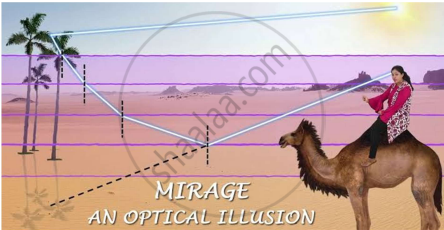Advertisements
Advertisements
Question
A concave mirror having a radius of curvature 40 cm is placed in front of an illuminated point source at a distance of 30 cm from it. Find the location of the image.
Solution
Using sign conventions, given,
Distance of object from mirror, u = − 30 cm,
Radius of curvature of concave mirror R = − 40 cm
Using the mirror equation,
\[\frac{1}{v} + \frac{1}{u} = \frac{2}{R}\]
\[ \Rightarrow \frac{1}{v} = \frac{2}{R} - \frac{1}{u}\]
\[ \Rightarrow \frac{1}{v} = \frac{2}{- 40} - \frac{1}{- 30} = \frac{1}{- 20} + \frac{1}{30}\]
\[ \Rightarrow \frac{1}{v} = \frac{- 30 + 20}{30 \times 20} = \frac{- 10}{30 \times 20}\]
\[ \Rightarrow \frac{1}{v} = - \frac{1}{60}\]
or, v = − 60 cm
Hence, the required image will be located at a distance of 60 cm in front of the concave mirror.
APPEARS IN
RELATED QUESTIONS
Give a scientific reason:
Danger signals are red in colour.
Why can’t we see clearly through fog?
Show with the help of a diagram, how unpolarised light from Sun gets linearly polarised by scattering.
Why does the Sun look reddish at sunset or sunrise ?
The image formed by a concave mirror
A thin lens is made with a material having refractive index
\[\mu = 1 \cdot 5\]. Both the side are convex. It is dipped in water \[\mu = 1 \cdot 33\]. It will behave like
A point object O is placed on the principal axis of a convex lens of focal length f = 20 cm at a distance of 40 cm to the left of it. The diameter of the lens is 10 cm. An eye is placed 60 cm to right of the lens and a distance h below the principal axis. The maximum value of h to see the image is
A concave mirror forms an image of 20 cm high object on a screen placed 5.0 m away from the mirror. The height of the image is 50 cm. Find the focal length of the mirror and the distance between the mirror and the object.
k transparent slabs are arranged one over another. The refractive indices of the slabs are μ1, μ2, μ3, ... μk and the thicknesses are t1 t2, t3, ... tk. An object is seen through this combination with nearly perpendicular light. Find the equivalent refractive index of the system which will allow the image to be formed at the same place.
Light is incident from glass (μ = 1.50) to water (μ = 1.33). Find the range of the angle of deviation for which there are two angles of incidence.
A point source is placed at a depth h below the surface of water (refractive index = μ). (a) Show that light escapes through a circular area on the water surface with its centre directly above the point source. (b) Find the angle subtended by a radius of the area on the source.
One end of a cylindrical glass rod (μ = 1.5) of radius 1.0 cm is rounded in the shape of a hemisphere. The rod is immersed in water (μ = 4/3) and an object is placed in the water along the axis of the rod at a distance of 8.0 cm from the rounded edge. Locate the image of the object.
Fill in the blank and rewrite the completed statement:
Very fine particles mainly scatter ______ light.
State any one difference between a primary rainbow and a secondary rainbow.
Explain the formation of primary and secondary rainbow.
| Case study: Mirage in deserts |
 |
|
To a distant observer, the light appears to be coming from somewhere below the ground. The observer naturally assumes that light is being reflected from the ground, say, by a pool of water near the tall object. Such inverted images of distant tall objects cause an optical illusion to the observer. This phenomenon is called mirage. This type of mirage is especially common in hot deserts. Based on the above facts, answer the following question : |
A diver at a depth 12 m inside water `(a_(µω) = 4/3)` sees the sky in a cone of semi-vertical angle
Between the primary and secondary rainbows, there is a dark band known as Alexandar’s dark band. This is because ______.
- light scattered into this region interfere destructively.
- there is no light scattered into this region.
- light is absorbed in this region.
- angle made at the eye by the scattered rays with respect to the incident light of the sun lies between approximately 42° and 50°.
